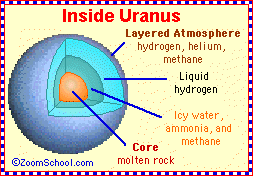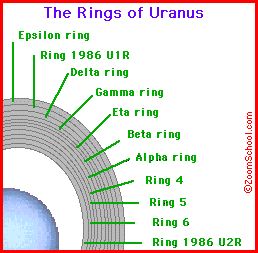|
Uranus
Once considered one of the blander-looking planets, Uranus (pronounced
YOOR un nus) has been revealed as a dynamic world with some of the brightest clouds in the outer solar system and 11 rings.
The first planet found with the aid of a telescope, Uranus was discovered in 1781 by astronomer William Herschel. The seventh
planet from the Sun is so distant that it takes 84 years to complete one orbit. Uranus, with no solid surface, is one of the
gas giant planets (the others are Jupiter, Saturn, and Neptune).
 The atmosphere of Uranus is composed primarily of hydrogen and helium, with a small amount of methane and traces of water
and ammonia. Uranus gets its blue-green color from methane gas. Sunlight is reflected from Uranus' cloud tops, which lie beneath
a layer of methane gas. As the reflected sunlight passes back through this layer, the methane gas absorbs the red portion
of the light, allowing the blue portion to pass through, resulting in the blue-green color that we see. The planet's atmospheric
details are very difficult to see in visible light. The bulk (80 percent or more) of the mass of Uranus is contained in an
extended liquid core consisting primarily of 'icy' materials (water, methane, and ammonia), with higher-density material at
depth. The atmosphere of Uranus is composed primarily of hydrogen and helium, with a small amount of methane and traces of water
and ammonia. Uranus gets its blue-green color from methane gas. Sunlight is reflected from Uranus' cloud tops, which lie beneath
a layer of methane gas. As the reflected sunlight passes back through this layer, the methane gas absorbs the red portion
of the light, allowing the blue portion to pass through, resulting in the blue-green color that we see. The planet's atmospheric
details are very difficult to see in visible light. The bulk (80 percent or more) of the mass of Uranus is contained in an
extended liquid core consisting primarily of 'icy' materials (water, methane, and ammonia), with higher-density material at
depth.
In 1986, Voyager 2 observed faint cloud
markings in the southern latitudes blowing westward between 100 and 600 kilometers (60 and 400 miles) per hour. In 2004, the
Keck Observatory in Hawaii used advanced optics to capture highly detailed images of Uranus as the planet approached its southern
autumnal equinox, when the equator will be vertically illuminated by the Sun.
Uranus' rotation axis
is nearly horizontal as though Uranus has been knocked on its side, as compared to most other planets in our solar system.
This unusual orientation may be the result of a collision with a planet-sized body early in the planet's history, which apparently
radically changed Uranus' rotation. Additionally, while magnetic fields are typically in alignment with a planet's rotation,
Uranus' magnetic field is tipped over: instead of aligning along the rotational axis, the magnetic axis is tilted nearly 60
degrees from the planet's axis of rotation, and is also offset from the center of the planet by one-third of the planet's
radius. Unlike the magnetic fields of Earth, Jupiter, and Saturn, which can be thought of as acting like dipole bar magnets,
the fields of Uranus (and Neptune also) are very irregular. Uranus' magnetic field is about 48 times more powerful than Earth's.
Even though Uranus is
tipped on its side and experiences seasons that last over 20 years, the temperature differences on the summer and winter sides
do not differ greatly because the planet is so far from the Sun. Near the cloud tops, the temperature of Uranus is -216 degrees
Celsius (-357 degrees Fahrenheit).

Because of the planet's unusual
orientation, Uranus' rings are perpendicular to its orbital path about the Sun. The 10 outer rings are dark, thin, and narrow,
while the 11th ring is inside the others and is broad and diffuse. Uranus has 27 known moons, named mostly for characters
from the works of William Shakespeare and Alexander Pope. Miranda is the strangest-looking Uranian
moon, appearing as though it were made of spare parts. The high cliffs and winding valleys of the moon may indicate partial
melting of the interior, with icy material occasionally drifting to the surface.

|
 |
|
|
|
 |
|
KEY FACTS:
Uranus
is the seventh planet from the sun in our solar system.
Huge, icy planet is covered with clouds and is encircled by a belt of 11 rings and 22 known moons. Uranus' blue color
is caused by the methane (CH4)
in its atmosphere; this molecule absorbs red light.
Uranus' rotational axis is strongly tilted on its side
(97.9°). Instead of rotating with its axis roughly perpendicular to the plane of its orbit (like all the other planets in
our Solar System), Uranus rotates on its side (along its orbital path). This tipped rotational axis gives rise to extreme
seasons on Uranus.
This
tipped rotational axis gives rise to extreme seasons on Uranus.
Because of
its almost-perpendicular axis orientation, there is a debate over which of Uranus' poles is its north pole. This debates leads
to yet another: Is Uranus spinning in a retrograde orbit (like Venus) or not (like the other planets)?
Uranus
is about 31,690 miles (51,118 km) in diameter. This is about 4 times the diameter of the Earth.
This gas giant is
the third-largest planet in our Solar System (after Jupiter and Saturn).
Uranus' mass is about
8.68 x 1025 kg. This is about 14 times the mass of the Earth. The gravity on Uranus is only 91% of the gravity
on Earth. A 100-pound person on Uranus would weigh 91 pounds.
Each day on Uranus takes 17.9 Earth
hours. A year on Uranus takes 84.07 Earth years; it takes 84.07 Earth years for Uranus to orbit the sun once.
Uranus
is over 19 times as far from the Sun as the Earth is; it averages 19.18 A.U.
At aphelion (the farthest point in its solar orbit) it is 1,850,000,000 miles (3,003,000,000 km) from the Sun. At
perihelion (the closest point in its solar orbit) it is 1,700,000,000 miles (2,739,000,000 km) from the Sun.
The
mean temperature on the surface of Uranus' cloud layer is -350°F (59 K). Uranus radiates very little heat in comparison with
the other gas giants, Jupiter, Saturn and Neptune).
Uranus
is a frozen, gaseous planet with a molten core. Uranus' atmosphere consists of 83% hydrogen, 15% helium and 2% methane.
Uranus
has 5 large moons (2 were discovered by Wm. Herschel in 1781, 2 were discovered by Wm. Lassell in 1851, and one by G. Kuiper in 1948) and many small moons
(which were discovered much later).
Uranus was discovered by the British astronomer William Herschel on March 13, 1781. Herschel
also discovered two of the moons of Uranus (Titania and Oberon) and some of the moons of Saturn.
This planet
was originally named in 1781 by the British astronomer William Herschel - he called it Georgium Sidus
(meaning "the Georgian planet") to honor the King George III of England. The name was later changed to Uranus, the ancient
mythological god of the sky, Ouranos. The name Uranus was suggested by the German astronomer Johann Elert Bode.
Uranus
has been visited by NASA's Voyager 2, whose closest approach was on January 24, 1986.
Atmosphere: The planet is shrouded in an icy cloud layer (made up of frozen
methane, ethane, and acetylene) circling this planet at 185 mph (300 kph. Uranus' icy atmosphere consist of 83% hydrogen,15% helium, and 2% methane. The outer layers of
the atmosphere are the coldest; temperature and pressure rise under the cloud layer.
Partially-solid Layers:
Beneath the atmosphere, there is a liquid layer of hydrogen and helium. As depth increases, this layer becomes more viscous,
and then partly solid. This layer may be composed of compressed water with ammonia and methane.
Core: Uranus has a molten rocky core
about 10,500 miles (17,000 km) in diameter and about 12,500°F (6927°C). This core may have a mass five times greater than
the mass of the Earth.
Uranus has
a belt of 11 faint, narrow rings composed of rock and dust. They circle Uranus is very elliptical orbits. These rings are
only a fraction of the size of Saturn's rings, and were only discovered in 1977.
|
|
|
 |
|
|
|

